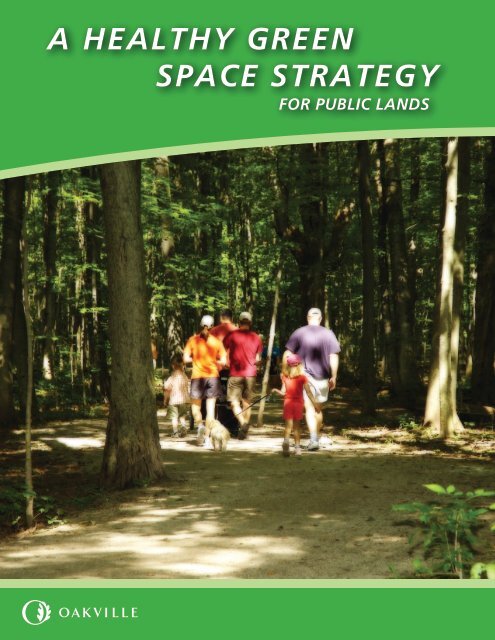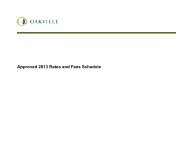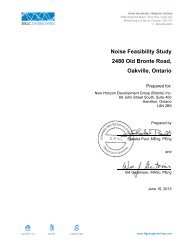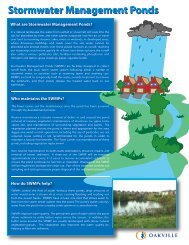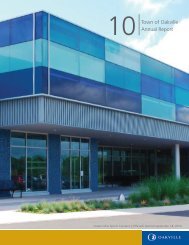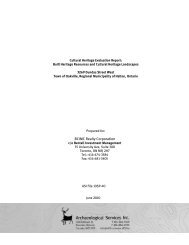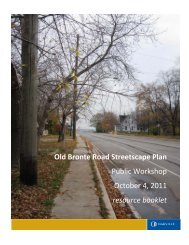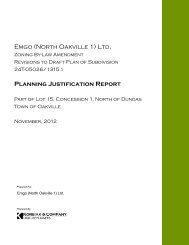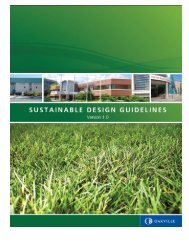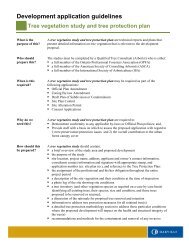A HEALTHY GREEN SPACE STRATEGY - Oakville
A HEALTHY GREEN SPACE STRATEGY - Oakville
A HEALTHY GREEN SPACE STRATEGY - Oakville
- No tags were found...
Create successful ePaper yourself
Turn your PDF publications into a flip-book with our unique Google optimized e-Paper software.
A <strong>HEALTHY</strong> <strong>GREEN</strong><strong>SPACE</strong> <strong>STRATEGY</strong>FOR PUBLIC LANDS
TA B L E O F C O N T E N T SIntroduction....................................................................................... 2Importance of Green Spaces............................................................... 3Green Space Quick Facts.................................................................... 4What We’re Doing............................................................................. 5Healthy Green Space Opportunities.................................................. 10Community Involvement................................................................... 11Partnerships...................................................................................... 11Future Opportunities........................................................................ 12References and Resources................................................................. 21Feedback.......................................................................................... 22Notes............................................................................................... 23A H e a l t h y G r e e n S p a c e S t r a t e g y f o r P u b l i c L a n d s
H E A L T H Y G R E E N S P A C E SI N T R O D U C T I O N<strong>Oakville</strong> is renowned for its abundance of public green spaces that enhance the quality of life for its residents. Thesegreen spaces have been carefully planned or designated and include passive and active parks, urban forests, valleylands, wetlands and other natural areas. Responsible land use planning is vital to the sustainability of a safe, healthy,and secure urban environment. Planning for our community involves both the natural and built environments toimprove our society and its land.The Town is working with other levels of governments, community organizations, businesses and individual residentsto better conserve, connect and restore the green spaces that are considered vital features of <strong>Oakville</strong>’s landscape.Stemming from Official Plan Amendment 198 Minutes of Settlement , this “Healthy Green Strategy for Public Lands”outlines the many initiatives the Town has underway to promote, maintain and enhance the long-term ecologicalhealth of the Town’s parks and open spaces and is the first stage in developing the strategy called for in thatsettlement. Ultimately, our goal is cleaner air, cleaner sources of water, more wildlife habitat, better soil conservation,new recreational opportunities, and a better connection to nature for both residents and visitors alike.While <strong>Oakville</strong>’s Environmental Strategic Plan (ESP), sets out principles for preservation, protection and ongoingenvironmental measures, this guide provides information needed for public discussion and development of one partof that plan. The OPA 198 Terms of Settlement outlines requirements for the Town as part of an OMB settlement with <strong>Oakville</strong>green andClear the Air Coalition. Information can be found at www.oakville.ca/media_files/102minutesSettlement.pdf.
I M P O R TA N C E O F G R E E N S PA C E SThere is a large demand in <strong>Oakville</strong> for recreational areas, bothactive and passive. With that in mind, public open spaces should “The Ontario Medical Association (OMA) hasbe functional - not just pretty places to view from a distance. estimated that air pollution in Halton Region<strong>Oakville</strong> residents are passionately involved in active sports, contributes to approximately 190 premature deaths,540 hospital admissions, 2,010 emergency roomincluding soccer, lacrosse, rugby, football, baseball, and lawnvisits, and 1 million minor illness days each year”bowling. Others are interested in passive pursuits, such as walking(OMA, 2005).along trails and quietly enjoying <strong>Oakville</strong>’s many natural areas. Infact, the number and variety of parks and open spaces contributessignificantly to the quality of life of <strong>Oakville</strong> residents and livability of the <strong>Oakville</strong> community.As part of the ecosystem, open green spaces are extremely important as they contribute to improved air quality,providing habitat for the wildlife, and by meeting the recreational needs of <strong>Oakville</strong> residents.About 16 percent of <strong>Oakville</strong> is considered to be public “green space” that includes the Town’s parks, urban forest, valleylands, wetlands and other natural areas. <strong>Oakville</strong>’s urban forest is a key part of <strong>Oakville</strong>’s overall green space. Withinthe Town, there are more than 120 kilometres of active streams, 50 woodlands of various sizes, and a wide variety ofwetlands and vegetation communities. There are also 100,000 trees on public streets, parks and valleys throughout<strong>Oakville</strong> and each year, the Town plants about 2,000 residential street trees and park trees in new developments.Overall there are 1.9 million trees in <strong>Oakville</strong>; 43% are Town-owned and 57% are distributed over 9 land use typeson private property and lands owned by other levels of government and non-government agencies. <strong>Oakville</strong>’s urbanforest canopy average is 29.1%.An important part of our urban forest is the Iroquois Shoreline Woods (ISW). The ISW is a 70 acre (35 hectare) naturalwoodland park designated as an Area of Natural and Scientific Interest (ANSI) by the Province of Ontario. It is one ofthe largest forested upland areas below the Niagara Escarpment between Toronto and Hamilton. While the land isowned by the Province of Ontario, these woods are managed by the Town of <strong>Oakville</strong>. <strong>Oakville</strong> has restricted the useof the ISW Park to passive recreation and conservation purposes. In 2006, this forest was designated as a CertifiedForest by Smartwood Canada in accordance with the principles of the internationally-recognized Forest StewardshipCouncil of Canada.Sixteen Mile Creek valley is another important natural feature within the Town of <strong>Oakville</strong>. This Candidate LifeScience Area of Natural and Scientific Interest (ANSI) is a wide deeply carved river channel that has developed diverseplant communities. The ravine is well wooded with high quality deciduous and mixed forests. The valley sides show avariability of plant cover due to the north/east and south/west aspects of the slopes. This provides habitat for variousvegetation species unique to this area that are usually found in more southern locations such as black maple, blackoak, sassafras and moonseed. Prairie grasses can also be found on dry south facing slopes.There are two other candidate ANSI sites in north <strong>Oakville</strong>. The Provincially Significant <strong>Oakville</strong> - Milton Wetlandsand Uplands is a candidate Life Science Upland representative of kettle and headwater wetlands and drier tablelandforests. The Trafalgar Moraine area is a candidate Earth Sciences ANSI as a Provincially Significant glacial feature.(Ontario Ministry of Natural Resources, September 2006).ANSI’s: Trafalgar Moraine Earth Science • Joshua’s Creek Pop-Up Earth Science • Bronte Creek Valley Earth Science• Iroquois Ridge Shoreline Woods Life Science • Bronte Creek Valley Life Science • Candidate <strong>Oakville</strong> - Wetland andUpland Life Science • Candidate Sixteen Mile Creek Valley Life ScienceA H e a l t h y G r e e n S p a c e S t r a t e g y f o r P u b l i c L a n d s
H E A L T H Y G R E E N S P A C E SG R E E N S PA C E S Q U I C K F A C T S<strong>Oakville</strong> has…••••••••••••1,400 hectares of parkland, 200 parks including 31waterfront parks and 700 hectares of valley land120 kilometres of active streams14 kilometres of Lake Ontario shoreline35 hectares of waterfront park, with 17 kilometres ofwaterfront trailApproximately 140 kilometres of park trails, manyfollowing valley landsMore than 50 woodlands of various sizes and a widevariety of wetlands and vegetation communitiesOver 900 species of plants, including 5 provincially rarespecies and 145 regionally or locally rare species185 bird species, 30 amphibian and reptile species, 29mammals and 58 fish species (Halton Natural Area Inventory)Three areas of Earth Science and four areas of LifeScience; Natural and Scientific InterestMore than 100,000 trees on public lands, maintainedby the Parks and Open Space Department withapproximately 2,000 new street trees planted per yearManaged public green spaces with virtual elimination ofpesticides since 200216 stormwater management ponds currently ownedby the Town with 12 coming under Town operationswithin 5 yearsAccording to a 2006 citizen survey, approximately 82 percentof residents considered the Town’s efforts to protect theenvironment to be very important and over 82 percent ofresidents consider the amount of green space available tobe very important.“Greenspace serves many different purposes and providesa number of public health benefits as well. It can also beused to separate emission sources, such as highways, fromsensitive land uses such as homes and schools. While treesand vegetation do release volatile organic compounds thatcombine with nitrogen oxides to produce ground-level ozonein the sunlight during the growing season, they also absorbsome air pollutants from the air and can trap airborne fineparticulate matter which prevents if from floating around inthe air. Trees and vegetation also capture greenhouse gaseswhich helps slow climate change. By providing shade, treescan also reduce the “heat island effect” that occurs whenpavement, concrete, and building in urban areas absorbheat.” (Sustainable Halton, Halton Region, 2007).
W H A T W E ’ R E D O I N GThe Town of <strong>Oakville</strong>’s commitment to environmental stewardship is showcased in the many programs, services andinitiatives undertaken every year. Take a look below and see how you can get involved.KEY INITIATIVESEnvironmental Strategic Plan -- Moving Ahead<strong>Oakville</strong> has developed an Environmental Strategic Plan (ESP) aspart of the Town’s “Blueprint <strong>Oakville</strong>” planning initiatives. TheESP outlines goals, targets and plans to achieve environmentalprotection and improvements across the Town.Many of the recommendations of the ESP (refer to pages 12 to 14)relate to the objectives of healthy green space management. Theserecommendations, brought forward through the community-baseddevelopment of the ESP, provide a framework for efforts to protect<strong>Oakville</strong>’s green spaces to ensure that they are healthy, maintainedand promoted. Specifically Goal 1 defines actions to sustain andenhance our natural resources - airsheds, watersheds, shoreline,landscapes, flora and fauna.Parks, Recreation, Culture and Library Master Plan (PRCL)The primary goal of the PRCL is to establish a long-range parks, recreation, culture and library strategy to enhancethe quality of life of all residents by promoting social, learning, cultural and recreational opportunities. Highlights ofthe 20-plus year master plan include more funding towards the extension and development of trails and the creationof new soccer fields.Key principles include providing leadership in environmental stewardship bypreserving, protecting and enhancing the Town’s unique natural and heritageresources, placing priority on protecting valley lands and waterfront lands,sustaining the urban forest and encouraging the greening of the Town. Thirtyone recommendations (refer to pages 15 to 18) outline actions to protect andenhance the Town’s parks, open space and trails.Urban ForestryThe Town’s Urban Forestry section is responsible for the planting, protection,maintenance and removal of trees on municipal property and for developingurban forestry policies for the Town. About 20,000 of the Town’s 100,000 treesare under active management. Urban Forestry staff routinely monitor the urbanforests for diseases and invasive insects. Staff also review Tree Preservation Plansfor new plans of subdivision, site plan applications, engineering and construction,Region of Halton capital projects, and utility installations to safeguard and protectTown trees.A H e a l t h y G r e e n S p a c e S t r a t e g y f o r P u b l i c L a n d s
H E A L T H Y G R E E N S P A C E SBest practices are included in the management of the Town’s urban forests. The Town has been undertaking a“prescribed burn” program at the Iroquois Shoreline Woods (ISW). This practice uses a deliberately set and carefullycontrolled low fire that does not harm larger trees but stimulates growth and encourages regeneration of naturallyoccurring and planted seedlings.<strong>Oakville</strong>’s ISW is Canada’s first municipal lower-tier forest to be certified by Smartwood in accordance with theprinciples and criteria of the Forest Stewardship Council (FSC). The Eastern Ontario Model Forest (EOMF) facilitatesthe process of obtaining various forest certificates for itself and its partners. Smartwood is the third part auditor forEOMF. Smartwood is accredited by the FSC and has the authority to certify forests as well managed in accordancewith the FSC Standards for Well-Managed Forests in the Central and Southern Great Lakes-St. Lawrence Forests ofOntario.Certification will assist the Town of <strong>Oakville</strong> to attain high standards of forest stewardship through annual independentthird party audits that ensure the best forest management practices are being applied.<strong>Oakville</strong> is incorporating new science into green space management. Street trees generally experience harsh conditionsas a result of limited usable soil volume and poor nutrient conditions for root growth. In an urban setting, the soilbecomes compacted from the weight of the pavement and trampling, limiting water infiltration as well as rootexpansion. The Town is working on a CU-Structural Soil TM pilot project, using an engineered soil intended for urbansites to provide adequate soil volumes and extra space for tree roots under pavement.Urban Forest Strategic Management PlanIn an effort to improve air quality in <strong>Oakville</strong>, the Town isestablishing an Urban Forest Strategic Management Plan forthe lands within the Town. This Plan will establish policies andpractices for urban forest preservation, replacement of agingtrees, and reforestation.Major objectives include:• Enhancing the urban forest by improving quality andquantity of the urban forest• Maintaining the municipal urban forest under the principlesof sound infrastructure management that recognize andpromote it as a “green” asset• Developing and implementing a public education program topromote awareness of public trees and care of private treesUrban Forest Effects Model (UFORE)UFORE is a predictive measurement tool that has beendeveloped by the United States Forest Service that uses variousdata to quantify urban forest structure and numerous urbanforest effects across the municipality. Using standardized fielddata from randomly located plots, local meteorological andair pollution data, the project calculates numerous attributesabout the urban forest.<strong>Oakville</strong> is at the forefront of urban forestry management withthe implementation of the UFORE model as an integral tool.
A random sample of 372 plots Town wide provided the data for input into the model. The data was analyzed bythe U.S. Forest Service, Syracuse, NY. A partner in the Town’s UFORE project is the Faculty of Forestry, University ofToronto. The University of Toronto has previously assisted the City of Toronto on a UFORE project.A Town report on the UFORE project is complete (October 2006). The report outlines 25 action items (refer to pages19 to 20) to enhance and protect <strong>Oakville</strong>’s urban forest. These action items as approved by Council in early 2007are being incorporated into the Urban Forest Strategic Management Plan.Natural Heritage System (NHS)An NHS is defined as a connected group of natural areas, and the native flora, fauna, and related geological featuresand landforms that contribute to the health and biodiversity of the natural environment. Natural heritage systemsmay include natural core areas (such as areas of natural and scientific interest, wetlands, or wildlife habitat), naturalcorridors (such as rivers, streams, lakeshores, or ravines), and natural connecting links (such as, but not limited to,hedgerows, tree lines, or restored road or rail allowances) that connect natural core and corridor areas. <strong>Oakville</strong>’sNHS for north <strong>Oakville</strong> will bring about 900 hectares into public stewardship. It will be a viable, functioning systemthat includes all key natural features within the urban area. In June 2006, several major north <strong>Oakville</strong> landownerscommitted to donating over 145 hectares (356 acres) of land to help create this sustainable natural environment. Thefinal NHS areas will be confirmed through approvals by the Ontario Municipal Board of the North <strong>Oakville</strong> SecondaryPlans. Further, Ontario Realty Corporation has set aside 263 hectares (650 acres) as part of the natural heritagesystem, which will be managed by Conservation Halton.North <strong>Oakville</strong> Secondary PlansNorth <strong>Oakville</strong> encompasses approximately 3,100 hectares (7600 acres) of land north of Dundas Street. The North<strong>Oakville</strong> East and West Secondary Plans, which will be part of the Town’s Official Plan, are tremendous achievementsthat are shared by the Town, the landowners, the public and other levels of government. The Plans, which arecomprehensive, balanced and sustainable, will aid in creating one of Canada’s most green and livable communities.The Plans break new ground in creating environmentally-friendly and sustainable communities supportive of alive/work balance. Development in North <strong>Oakville</strong> (based on the New Urbanism approach) will be transit-friendly,walkable, compact and a diverse community for approximately 50,000 people. With employment areas to support25,000 new jobs, North <strong>Oakville</strong> will reduce the need for lengthy commuting and promote the use of alternativetransportation such as walking, cycling and transit. Information on the North <strong>Oakville</strong> Secondary Plans can be foundat www.oakville.ca/bponosp.htm.OTHER INITIATIVES20-Minute MakeoverYear after year, litter continues to make headlines, and the message is clear. Litter impacts property values, invitestheft and damage, creates a breeding ground for fire and disease, creates safety hazards, and costs money tocontrol. <strong>Oakville</strong>’s 20-Minute Makeover is an annual event that asks citizens to get outside for 20 minutes to pick uplitter around their workplace, school or home. In past years, more than 10,000 people across <strong>Oakville</strong> took part inthe event to clean up their community.Adopt-a-Park, Adopt-a-Trail, Adopt-a-Road<strong>Oakville</strong>’s Pick-a-Parcel program comprising the ‘Adopt-a-Park, Trail or Road”, offers volunteers an opportunity tomake a contribution to the <strong>Oakville</strong> community by helping to clean up the Town’s parklands and open spaces. Withover 1,350 hectares of playing fields, meadows and natural parkland and over 140 km of trails, the Town encouragesA H e a l t h y G r e e n S p a c e S t r a t e g y f o r P u b l i c L a n d s
H E A L T H Y G R E E N S P A C E Sthe support of volunteers to help maintain its diverse park system. Volunteers play an important role in keeping<strong>Oakville</strong>’s parks clean and beautiful by participating in clean-ups and litter pick-up, horticultural bed maintenanceand a variety of classroom environmental projects.Trail GuideThe Town partnered with local agencies in a Conservation Halton-led initiative to develop “Halton Hikes: 50 GreatHiking Trails” to support outdoor adventures close to home. (Conservation Halton. 2007)Arbour WeekThe Town has been celebrating Arbour Week for over 25 years to raise awareness about the important role of treesin creating and maintaining a healthy environment. Each year, Grade 4 school children in <strong>Oakville</strong> are invited byTown Urban Forestry staff to participate in planting a shade tree at their school. As part of Arbour Week celebrations,the Town has planted more than 1,000 oak seedlings at prime sites in Iroquois Shoreline Woods Park.Pesticide By-LawIn February 2007, Town Council approved Pesticide By-Law 2007-036 with amendment By-Law 2007-123, toregulate the use of pesticides within the Town of <strong>Oakville</strong>. The by-law comes into effect on January 1, 2008. By-Law implementation is supported by an outreach education, and enforcement program. Refer to www.oakville.cafor <strong>Oakville</strong>’s Guide to Gardening Naturally for more information on how to comply with the by-law.Naturally Green - Pesticide AwarenessNaturally Green is a partnership among <strong>Oakville</strong>, Halton Region, the City of Burlington, the Town of Milton andthe Town of Halton Hills. In 2003, the partners launched a public education and awareness program to inform thepublic about the potential risks of and alternatives to pesticides. The Naturally Green education program encouragesresidents to consider alternatives for growing a healthy lawn and garden.The Town of <strong>Oakville</strong> has developed an active program to virtually eliminate the use of pesticides on public landsand uses pesticides on an emergency basis only in compliance with the new by-law. Using an ecological approachto the management of plant health problems response is based first on horticultural practices, with other controls(biological, cultural, genetic or mechanical) applied only when necessary, in compliance with the Pesticide By-law2007-036. This framework serves to protect human health and respects the environment.The Town focuses on best management practices, e.g. in turf management, and alternatives that will improve thesustainability of <strong>Oakville</strong>’s green spaces.These include:•••••••••Different cutting practices to increase the hardiness of turf and reduce weed invasion.The installation of water efficient centralized weather-based irrigation systems.Using alternative ground covers within boulevards.Fertilization programs based on soil analysisIdentifying acceptable ground cover material, which strengthens soil structure, supports wildlife habitat, and isresilient as well as aesthetically pleasing.Increasing mowing height during lawn maintenance to increase the vigor of the turf and reduce emissions.Aquaciding (applying hot water) instead of using non-selective weed killers on hard surfaces, medians, playgroundsand splash pads.Using horticultural strength vinegar in horticulture display areas.Increased use of naturalization.
NaturalizationNaturalization is a process by which altered or degraded ecosystemsare managed to regenerate into a more natural area consisting ofnative species. The term is used to indicate a movement towardsnatural and diverse landscapes, as well as ecosystems that haveless human interference or management. They might be wetlands,meadows, or woodlots.Naturalization projects in <strong>Oakville</strong> include:Lower Wedgewood Creek: Stream bank protection through theuse of naturalized techniques. Components such as live stakes,fascines, pools and bend-way weirs have been constructed toaddress bank erosion.Munn’s Creek: This project re-introduced a stream into aneighbourhood following 30+ years of being buried underground.Fourteen Mile Creek: A stream restoration project embracingbioengineering solutions, river training devices, and habitatenhancements.Park Shoreline Improvements: Restoration of one kilometre ofshoreline to replace deteriorated structures with effective protection,including fish habitat and public walkway enhancements.<strong>Oakville</strong> Environmental FundThe Town of <strong>Oakville</strong> worked with the Community Foundationof <strong>Oakville</strong> to set up an endowment fund, specifically to preserveand enhance the quality of <strong>Oakville</strong>’s environment. This <strong>Oakville</strong>Environmental Fund (OEF) will provide a legacy for futuregenerations. Working with local organizations, the OEF willconsider projects that:•••Preserve and enhance the natural beauty of our lands, parks,rivers and shorelinesProtect native species of plants and wildlifePromote environmentally friendly behaviours that reduce energyand water consumption and the strain on local landfill sites.A H e a l t h y G r e e n S p a c e S t r a t e g y f o r P u b l i c L a n d s
H E A L T H Y G R E E N S P A C E SH E A LT H Y G R E E N S PA C E S O P P O R T U N I T I E SIn developing this guide, meetings were held with Town staff with responsibilities related to green space management.The meetings helped to identify the relationship of this guide to the Environmental Strategic Plan, the Parks, Recreation,Culture and Library Master Plan, the Urban Forestry Strategic Management Plan, the Urban Forest Effects Modelresults, departmental projects and practices, and established community partnerships.A number of future opportunities were identified within the Town’s key initiatives that support the Town’s greenstrategies for public lands to:•••••••••••••••Develop and implement management plans foridentified sensitive areas.Develop and distribute a land stewardship guidefor land developers.Assess local urban forest cover and develop andattain targets for urban forest cover.Create a campaign to help residents recognizeand reduce the number of invasive species.Encourage households and businesses to implementsome form of ecological landscaping.Naturalize 25 percent of the Town’s publiclyowned open space by 2010.Have 25 percent of <strong>Oakville</strong>’s schools withecologically landscaped areas by 2010.Implement a community-led Native Plant Salvageprogram.Reclaim water for irrigation.Continue the work of Halton Partners forNaturally Green.Develop and maintain a contiguous network ofsafe walking paths throughout <strong>Oakville</strong>.To decrease the amount of litter in <strong>Oakville</strong>.Incorporate sustainable development practices,provincially-approved Places to Grow concepts,and consideration for the community, culture,health, safety, employment and environmentduring construction and development.Increase, protect and improve access to existinggreen spaces and outdoor recreational andleisure areas.Continue to promote the harbors, festivals andrecreational tourism to support communityvitality and ecotourism.Augment the <strong>Oakville</strong> Environmental Fund.•1 0
C O M M U N I T Y I N V O LV E M E N TAs stewards of the natural environment, the Town of <strong>Oakville</strong> and its citizens, have a significant influence over thehealth of the place we call home.The Town is committed to environmental protection and promoting the awareness of environmental policies, issuesand initiatives.Involving the community is a major component of this guide to healthy green spaces. <strong>Oakville</strong> realizes that in orderto successfully reach the targets set within its many environmental initiatives, an aware, educated and active publicis essential.PA R T N E R S H I P S<strong>Oakville</strong> is known for its tremendous community involvement. Although we cannot name every person or organizationthat gives back to our community, we have compiled a list of our partners for those looking to get involved. Thefollowing groups have acted as stewards of the environment by participating in or donating to community-basedprojects that help improve green spaces within <strong>Oakville</strong>. See following sections for references and resources.• 20-Minute Makeover participants and sponsors• Abbey Park High School• Adopt-a-Park, Adopt-a-Trail, Adopt-a-Road partners• Bronte Horticultural Society• Community Foundation of <strong>Oakville</strong>• Conservation Halton• Credit River Anglers Association• Environment Canada• Evergreen Foundation• Families and Nature Club• Gardens off Drugs• Ground Breakers <strong>Oakville</strong>• Halton Environment Network• Halton Region• Naturally Green• <strong>Oakville</strong> Community Centre for Peace, Ecology &Human Rights• <strong>Oakville</strong>green Conservation Association• <strong>Oakville</strong> Horticultural Society• <strong>Oakville</strong> residents’ associations• Petro-Canada• South Peel Naturalists Club• T.A. Blakelock High School• Toronto Dominion Friends of the EnvironmentA H e a l t h y G r e e n S p a c e S t r a t e g y f o r P u b l i c L a n d s 1 1
H E A L T H Y G R E E N S P A C E SF U T U R E O P P O R T U N I T I E SThe opportunities included in the recommendations within the Town’s Environmental Strategic Plan (ESP) are:OPPORTUNITYDevelop and implementmanagement plans for 10previously identifiedsensitive areas.Reference• ESP (Action 1.1.1)• North <strong>Oakville</strong> Secondary Plan(NOSP)/Subwatershed StudiesTASKS/PROGRAMS• Identify sensitive coreareas based on outcome ofsub watershed and regionalstudies.• Develop and implementmanagement plansPARTNERSHIPS/RESPONSIBILITY• Town (lead)• Community Partners• Region• Conservation HaltonTIME FRAMEShort term(1-2yrs),Medium Term(2-5yrs)Develop and distribute a landstewardship guide for landdevelopers• Consult landowners,developers and builders• Develop and distribute guide• Town (lead)• Conservation Halton• Industry professionalsShort term(1-2yrs)Reference• ESP (Action 1.1.2)Assess local urban forestcover and develop and attaintargets for urban forest coverbased on original assessmentReference• Urban Forestry StrategicManagement Plan• ESP (Action 1.1.4)• Conduct tree assessment• Develop an Urban ForestryManagement Plan• Private Tree By-lawconsultation• Create education and publicawareness campaign• Encourage on-going treeplantings• Develop communitypartnerships• Town (lead)• Community Partners• Region• Conservation HaltonShort term(1-2yrs),UnderwayCreate a campaign tohelp residents recognizeand reduce the number ofinvasive species.Reference• ESP (Action 1.1.5)• Parks and Open Spaces• Develop an identificationguide for invasive species• Develop and distributeinformation guide• Offer information andsources for native plantmaterial that is a suitablereplacement for invasive species• Create education and publicawareness campaign• Town (lead)• Community Partners• Conservation HaltonShort term(1-2yrs)Establish and grow an<strong>Oakville</strong> Environmental FundReference• ESP (Action 1.1.6)• Increase the amount of moneyin the fund• Number and type ofenvironmental initiativescarried out• Community Foundationof <strong>Oakville</strong> (lead)• TownUnderway1 2
OPPORTUNITYNaturalize 25 percent of theTown’s publicly-owned openspace by 2010.Reference• ESP (Action 1.4.2)• Parks and Open Space• Conservation Halton• RegionTASKS/PROGRAMS• Town to identify priority areasfor naturalization• Town to set percentage peryear to naturalize to meet 25percent goal.• Develop partnerships withConservation Halton, schools,community groups and theRegion to plant native specieson public landsPARTNERSHIPS/RESPONSIBILITIES• Town (lead)• Community Partners• Region• Conservation HaltonTIME FRAMEUnderway/Medium Term(2-5yrs) -Long Term(5yrs +)Develop and maintain anetwork of safe walking andcycling paths throughout<strong>Oakville</strong>.Reference• Planning Services• Parks and Open Space• Recreation and Culture• ESP (Action 3.2.1)• Parks, Culture, Recreation &Library Master Plan (PRCL)• Conduct a community-basedinventory of the existing bike/walking trail network: analyzethe coverage, extent, and gaps.• Ensure that bike and walkingpaths are separate topromote safety, and that eachis connected to major activitygenerators• Promote walking/cycling as atransportation alternative• Town (lead)Short term(1-2yrs)/Medium Term(2-5yrs)/Long Term(5yrs +)Decrease the amount of litterin <strong>Oakville</strong>.Reference• ESP (Action 4.1.1)• PRCL• Parks and Open Space• Roads and Works• Communications• Improve and maintaincommunity cleanliness byincreasing the number ofgarbage cans in public areas,maintaining anti-littercampaigns, and encouragingpeople to adopt a trail and/orparks• Investigate design optionsand work towards developinggarbage cans with privatesector partners• Community (lead)• Town• Community Foundationof <strong>Oakville</strong>UnderwayImprove access togreenspace andrecreational areas.Reference• ESP (Action 4.4.3)• PRCL• Parks and Open Space• Recreation and Culture• Ongoing communicationsshowcasing all outdoorrecreational areas, parks, trailsand green spaces• Town (lead)UnderwayA H e a l t h y G r e e n S p a c e S t r a t e g y f o r P u b l i c L a n d s 1 3
H E A L T H Y G R E E N S P A C E SOPPORTUNITYIncorporate sustainabledevelopmentpractices,ProvinciallyapprovedPlaces to Growconcepts,and considerationduring construction anddevelopment.Reference• ESP (Action 4.2.1)• Development Services• Planning Services• PRCL• NOSP/SubwatershedStudies• Official Plan (OP) ReviewTASKS/PROGRAMS• Continue to considerand incorporate sustainabledevelopment , LEED principlesand concepts when planningnew communities• Complete communityimprovement plans anddevelop streetscape guidelinesand walkable, mass transitoriented design• All new development tocomply with Sub watershedStudies• Consider the Task Forceon Tools and Mechanismsto Support Intensification,Revitalization andRedevelopmentPARTNERSHIPSResponsibility• Town (lead)• Region• Conservation Halton• Province• Developers• CommunityTIME FRAMEUnderway/Short term (1-2yrs)/Medium Term (2-5yrs) -Long Term (5yrs +)Increase and protect existinggreen spaces and outdoorrecreational and leisureareas.Reference• ESP (Action 4.4.1)• PRCL• Parks and Open Space• Recreation and Culture• NOSP/SubwatershedStudies• Create green space inventoryon the and outdoorrecreational areas to identifygaps and assess areas forimprovement.• Increase the number of greenspaces, parks and outdoorrecreational facilities• Monitor the quality ofoutdoor recreational andleisure areas and recommendimprovementsResponsibility• Town (lead)Underway/Short term (1-2yrs)/Medium Term (2-5yrs) -Long Term (5yrs +)Have 25 percent of<strong>Oakville</strong>’s schools withecologically landscapedareas by 2010.Reference• ESP (Action 1.4.3)• Determine percentage ofschools that have naturalizedareas• Design naturalized areas andimplement maintenance plans• Create a program to achieve apercentage of naturalizationeach year• Create award for schools• Conserve natural areas/features when new schoolsare builtResponsibility• Local school boards(lead)• Town• Community Partners• Region• Conservation HaltonUnderway/Medium Term (2-5yrs) -Long Term (5yrs +)1 4
The opportunities included within the Parks, Recreation, Culture, and Library Master Plan are:Topic AreaClassificationProvision StandardsLand RequirementsParklandAcquisition andDevelopmentC1C2C3C4C5C6C7C8C9RecommendationThe North <strong>Oakville</strong> Secondary Plans should include the provision of trails,walkways and/or bicycle paths in “core preserve areas” and “linkage preserveareas”, where appropriate.Within developing residential areas, the Town shall continue to strive to maintain aprovision level of 2.2 hectares of municipal Neighbourhood and Community parklandper 1,000 population.Although there are presently no major gaps in terms of parkland and natural areadistribution in <strong>Oakville</strong>, the Town should ensure that geographic accessibility remainsa priority in the future. Although the Town may decide to locate parkland in nonresidentialareas (where appropriate) in order to meet overall provision standards, inurbanized residential areas the Town should attempt to provide one or more playgroundswithin 800 metres of all residential units.To keep pace with growth, the Town should continue to target the acquisition and/or dedication of appropriate levels of Neighbourhood and Community parkland (2.2hectares/1000 residents) in new residential communities.Should future parkland dedications not be sufficient to maintain a supply of 2.2 hectaresof active parkland per 1,000 residents, the Town should consider increasing its parksupplies in these areas. While acquisition of new parkland may be the most favourableapproach to ensuring long-term access to parks, appropriate non-acquisition basedstrategies should also be considered.The Town should continue to implement the policies in its Official Plan regarding theestablishment of a continuous linear park along the Lake Ontario waterfront. To achievethis goal, acquisition, dedication, easement agreements, etc. should be pursued.The Town should acquire parkland at the maximum applicable rate as permitted by thePlanning Act. For each opportunity, the Town should consider the benefits of bothparkland dedication and cash-in-lieu prior to deciding which requirement to pursue.Should the Town decide to acquire parkland through means other than dedication, nonacquisitionbased options should be fully explored prior to acquiring additional land.The Town should continue its practice of not accepting passive “natural area” lands aspart of the required parkland dedication.A H e a l t h y G r e e n S p a c e S t r a t e g y f o r P u b l i c L a n d s 1 5
H E A L T H Y G R E E N S P A C E STopic AreaParklandAcquisition andDevelopment(continued)Waterfront ParkSystemLand & ParkStewardshipPark Design,Location,Maintenance &ManagementC10C11C12C13C14C15C16C17C18RecommendationIn areas that presently have adequate supplies of active parkland, acquisition of nonmunicipalparkland (e.g., schoolyards of surplus schools) should not pursued unless thereare no reasonable alternatives (e.g., publicly accessible neighbourhood or communityparks with playground equipment) within approximately 800 metres.The Town should continue to implement the policies in its Official Plan relating to linearwaterfront parks. There remains a strong desire to acquire or secure a continuous linearstrip of public parkland across the entire <strong>Oakville</strong> shoreline.The Town should develop a Waterfront Parks Linkage Plan outlining a phased strategyto establish a continuous linear strip of public parkland across the entire <strong>Oakville</strong>shoreline.The Town should continue to work to improve awareness and understanding within thecommunity about the natural heritage system, the features and areas it contains, andhow to maintain and enhance its resources.While the Town will continue to promote community-building and tourism-generatingspecial events that take place in its parks, primarily throughout the summer months, thisshall not be done at the expense of the environmental integrity of the parks.The Town should continue to maintain a commitment to accessibility, safety, andsecurity within its entire parks and pathway system. In recognition of the Town’s agingpopulation, greater attention should be paid to the development of amenities such aswashrooms (in Community Parks) and benches/seating areas.Within Community Parks the Town should, wherever possible, cluster the same typeof playing fields together to increase a sense of form and function. Such parks shouldalso include contain washrooms, water fountains, electrical outlets, benches andsafe, pedestrian-friendly pathways, etc. A greater emphasis should also be placed onproviding more informal space in new parks in order to promote unstructured andorganized activities, as well as emerging interests.When developing new parkland, the Town should attempt to maintain as much existingforest cover as possible (while still providing for appropriate location and design of thenecessary recreation features).The Town, in consultation with residents, should continue to identify and pursueopportunities within existing and future parks for naturalization/ restoration initiatives.1 6
Topic AreaPark Design,Location,Maintenance &Management(continued)Trails System &Natural HeritageConnectionsC19C20C21C22C23C24C25RecommendationIn developing parks with both active/man-made and passive/natural elements, clearseparations between active and passive park areas should be established.In order to foster partnership relationships to enhance the parks system, the Townshould continue to:a) implement its community partnership policy to guide community development andmaintenance of additional parkland features beyond basic level standards;b) seek community sponsorships and partnerships to support the development of trails,pathways, and park features;c) work with surrounding municipalities, school boards, and organizations to develop aregionally integrated trail and linkage system;d) promote Town-wide and corporately sponsored “greening” programs; ande) promote its community garden plot program and consider appropriate new locationssubject to local community interests.New neighbourhood parks should be designed to rely on on-street parking in order tomaximize parkland usage and intensification. Off-street parking should be provided forany new park with more than two playing fields.Parks containing a number of lighted fields designed for adult and tournament play canbe located in commercial or light industrial areas. Parks designed primarily for childrenshould not be located in commercial or industrial areas.Future community centres and community parks should be situated adjacent to eachother (where possible) to capitalize on synergies of use and economies of scale. Wherepossible, future parks and schools should also be located adjacent to each other.To improve access to and throughout the Town’s natural heritage system, the Townshould continue to develop pathways and linkages among components of its park andopen space system. (From Conservation Halton: Trails should be located and designatedto minimize any impact on the environment.)The Town should establish a policy that clearly articulates the parameters and standardsrelating to signage at trail access points and along trails. In general, improved publicawareness of trail locations, routes, surfaces, and support facilities (e.g., washrooms)should be made a priority.A H e a l t h y G r e e n S p a c e S t r a t e g y f o r P u b l i c L a n d s 1 7
H E A L T H Y G R E E N S P A C E STopic AreaTrails System &Natural HeritageConnections(continued)C26C27C28C29C30C31RecommendationWherever possible, trails, pathways and bike lanes should travel to or from public transitstops (including GO stations) and appropriate bike racks should be provided at majortransportation hubs.Trails through woodlots, natural areas, and top-of-bank setbacks should continue to becovered with limestone screenings, with only steep slopes being paved. Walkways andpathways in Neighbourhood Parks and Village Squares north of Dundas Street shouldhave an asphalt or hard surface of another type.The Town should establish as a high priority allocating additional resources to trailmanagement, as this is a service that most <strong>Oakville</strong> residents value and would like tosee expanded.The Town should continue to promote and enhance its Adopt-a-Trail program as a wayof improving maintenance and offsetting some costs.For the benefit of all <strong>Oakville</strong> residents and to ensure continuity with Waterfront Trailstandards in neighbouring municipalities, the Town should upgrade the Waterfront Trailthrough paving and improving the continuity of facilities and the quality of signage andcrossings.The Town should consider establishing a paved trail loop/route in a park (or a combinationof connected parks) in North <strong>Oakville</strong> in order to provide additional opportunities forinline skating, biking, walking, etc. in the community (particularly the north end asthe south has the Waterfront Trail). This trail should be linked to the Town-wide trailsystem.1 8
The opportunities included within the Urban Forest Effects Model (UFORE) report are:Summary of Action ItemsACTION ITEM 1:Obtain detailed outputs on the human health benefits from<strong>Oakville</strong>’s urban forest by combining the results of the AirQuality Benefits Assessment Tool (AQBAT) and UFORE modelsin conjunction with the Halton Region Health Department.ACTION ITEM 2:The Finance Department and the Parks and Open SpaceDepartment should review the 10 Year Capital Forecastto ensure that operating costs for street trees and parktrees and woodland parks are captured based on amaintenance standard recommended in the Urban ForestStrategic Management Plan (UFSMP).ACTION ITEM 3:The UFSMP will develop a private urban forest stewardshipeducation program.ACTION ITEM 4:The UFSMP should outline the creation of a proactiveunder planting program in those communities at risk ofdecreasing urban forest canopy cover due to aging trees.ACTION ITEM 5:It is recommended that the U.S. Department of Agriculturemodify the UFORE plot tally sheet to record the type of energyused for heating (gas, electricity, oil, etc) on each householdwhere trees are over 20 feet tall and within 60 feet ofresidential buildings three storeys or less in height in order tomore accurately calculate the value of energy savings.ACTION ITEM 6:The Town should prepare an Emerald Ash Borer Action Plan.ACTION ITEM 7:It is recommended that UFORE consider incorporatingLeaf Area Density and Potential Leaf Area Density.ACTION ITEM 8:The Town should investigate the feasibility of an incentiveprogram for private large stature trees in order tomaximize filtration of criteria pollutants and greenhousegas emissions.ACTION ITEM 9:The Forestry Section should work with the Forest GeneConservation Association to create a gene conservationprogram for the Town.ACTION ITEM 10:The Parks and Open Space Department should identifyopportunities for parks naturalization that contributesto the forest canopy and prepare capital budget costs.ACTION ITEM 11:The Forestry Section should Chair an interdepartmental/interagency Technical Advisory Committee to recommend:a) Urban forest canopy cover targets for <strong>Oakville</strong> and; b)How key Town Departments can contribute to achievingthese targets.ACTION ITEM 12:The Town should undertake a pilot rooftop gardendemonstration project that can contribute to forestcanopy coverage.ACTION ITEM 13:The Town should investigate the feasibility of tradingcarbon credits.ACTION ITEM 14:Amend the Town’s Official Plan, Part C, Section 10.4 torecognize the municipal urban forest as a component ofthe municipality’s “infrastructure.”ACTION ITEM 15:The Tree Habitat Design Guidelines for <strong>Oakville</strong> should bereviewed with the interdepartmental Technical AdvisoryCommittee identified in ACTION ITEM 11 to incorporatethem into the Town’s urban design standards of keyTown departments.ACTION ITEM 16:Town Council should endorse the initiative of theInternational Society of Arboriculture, Ontario Chapter,which calls upon the Ontario Ministers of MunicipalAffairs & Housing and Natural Resources to supportA H e a l t h y G r e e n S p a c e S t r a t e g y f o r P u b l i c L a n d s 1 9
H E A L T H Y G R E E N S P A C E Shealthy urban forests in Ontario as outlined on the website of the Canadian Urban Forest Network (http://www.treecanada.ca/programs/urban forestry/cufn/cufn.html).ACTION ITEM 17:The interdepartmental Technical Advisory Committee,identified in Action Item #11, should investigate thepotential role of zoning by-laws to reserve for the use ofthe tree, the land which supports the tree.ACTION ITEM 18:The Forestry and the Design & Construction Sections willwork together to expand the CU- SOIL pilot project whichwas initiated in Uptown Core in 2005.ACTION ITEM 19:THE UFSMP to identify a prime site management programfor large-stature and medium-stature trees.ACTION ITEM 20:The Parks and Open Space Department to establish a “soilrestoration program” as part of its prime site managementprogram.ACTION ITEM 22:The Town to review the Site Plan design guidelinesfor parking lot design with respect to tree habitat andestablish targets for urban forest canopy cover.ACTION ITEM 23:Forestry staff to conduct a pilot project to fine-tune infraredphotography as a cost saving technique to identifyareas that contain hazard trees.ACTION ITEM 24:The Forestry Section to submit a 2007 capital projectbudget request to conduct an inventory of Town ownedstreet trees, Town woodlands plus heritage trees as wellas develop a capital budget schedule to inventory thebalance of the Town trees in the open space land usetype.ACTION ITEM 25:The Forestry Section will update UFORE every fouryears and provide a State of the Urban Forest Report toCouncil.ACTION ITEM 21:The UFSMP will recommend a pruning cycle for Town trees.2 0
R E S O U R C E SBronte Horticultural Societywww.brontevillage.net/bhs.htmCommunity Foundation of <strong>Oakville</strong>www.thecfo.orgConservation Haltonwww.conservationhalton.on.caEnvironment Canadawww.ec.gc.caEvergreenwww.evergreen.caGround Breakers <strong>Oakville</strong>www.groundbreakersoakville.com<strong>Oakville</strong> Community Centre for Peace,Ecology & Human Rightswww.oakvillepeacecentre.org<strong>Oakville</strong> Horticultural Societywww.oakvillehort.orgOntario Ministry of Natural Resourceswww.mnr.gov.on.caConservation Ontario and TorontoRegion Conservation Authoritywww.trca.on.caPlaces to Growwww.pir.gov.on.ca/userfiles/HTML/cma_4_35657_1.htmlRegion of Halton Partners for Naturally Greenhttp://www.halton.ca/health/pesticides/default.htmThe Families and Nature Clubwww.ford.ca/english/LearnAbout/ConsumerEd/Environ-ment/Commitment/EnvironmentalInitatives/Community-Outreach.aspTown of <strong>Oakville</strong> Urban Forestrywww.oakville.ca/forestry.htmTown of <strong>Oakville</strong> Pesticide Awarenesswww.oakville.ca/env-pesticide.htmTown of <strong>Oakville</strong> Volunteer Opportunitieswww.oakville.ca/volunteeropps.htm<strong>Oakville</strong>green Conservation Associationwww.oakvillegreen.orgGardens Off Drugswww.gardensoffdrugs.comA H e a l t h y G r e e n S p a c e S t r a t e g y f o r P u b l i c L a n d s 2 1
H E A L T H Y G R E E N S P A C E SR E F E R E N C E SCanadian Climate Change Impacts and Adaptation Research Network (C-CIARN). February 2006. Adapting toClimate Change. An Introduction for Canadian Municipalities.Conservation Halton. May 2005. Guidelines for Stormwater Management Ponds and Creek Realignment PlantingPlans and Tree Preservation Plans.Conservation Halton — Natural Area Inventory (managed database).Conservation Halton. 2007. Halton Hikes: 50 Great Hiking Trails.Environment Canada. 2004. How much Habitat is Enough? A Framework for Guiding Habitat Rehabilitation inGreat Lakes Areas of Concern.Halton Region. 2007. Sustainable Halton. Air Quality, Human Health and the Built Environment.OMNR. September 2006. Candidate <strong>Oakville</strong> - Milton Wetlands and Uplands Life Science Area of Natural andScientific Interest.OMNR. September 2006. Candidate Trafalgar Moraine Area of Natural and Scientific Interest - Earth Sciences.Ontario Medical Association (OMN). 2005. The Illness Costs of Air Pollution in Ontario.Ontario Ministry of Natural Resources. September 2006. Candidate Sixteen Mile Creek Valley Life Science Area ofNatural and Scientific Interest.Town of <strong>Oakville</strong>. April 25, 2006, May 10, 2006. Stormwater Pond Management Maintenance Manual andAssociated Policy and Procedures.Town of <strong>Oakville</strong>. May 2006. Official Plan Review Preliminary Directions Report.Town of <strong>Oakville</strong>. June 2006. Parks, Recreation, Culture and Library Master Plan.Town of <strong>Oakville</strong>. October 25, 2005. Environmental Strategic Plan for the Town of <strong>Oakville</strong>.Town of <strong>Oakville</strong>. October 2006. <strong>Oakville</strong>’s Urban Forest: Our Solution to Pollution. Urban Forest Effects Model(UFORE Report)F E E D B A C KWe welcome your feedback regarding this publication and the progress it describes. Please share your comments byemail at environment@oakville.ca or by phone at 905-845-6601 ext. 3299.This document was devised as required by Official Plan Amendment 198 Minutes of Settlement and outlines themany initiatives the Town has underway to promote, maintain and enhance the long-term ecological health of theTown’s parks and open spaces.2 2
N O T E SA H e a l t h y G r e e n S p a c e S t r a t e g y f o r P u b l i c L a n d s 2 3
H E A L T H Y G R E E N S P A C E SN O T E S2 4


